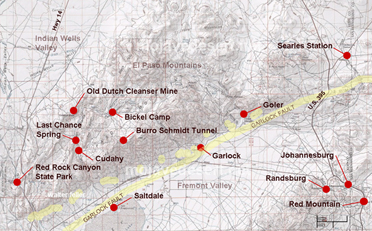Last Chance Canyon
Manly and Rogers on their heroic walk to save a party of lost 49er's made their way through this rugged canyon. The name however, came from the gold-seekers chasing the rainbow in the late 1800's, well after the gold fields in northern California were pretty much picked over. This was the canyon Burro Schmidt worked so hard to avoid by digging his famed "shortcut.



















Last Chance Canyon is a scenic desert region in the El Paso Mountains of California, known for its colorful geology, ancient fossils, and historical significance. It was once used by Native Americans as a hunting ground, while in the 19th and 20th centuries, it saw heavy mining activities that have now been abandoned to leave remnants of old mines and cabins. Nowadays, people go there to hike, explore, or engage in off-road adventures. The area boasts unique rock formations and historical sites, offering both natural beauty and a view into the region's past. There are flash floods that visitors must be wary of, and they have to adhere to conservation guidelines.


Also see:
El Paso Mountains Wilderness
The El Paso Mountains drop into this Wilderness from the southeast, with Black Mountain, at 5,244 feet, serving as the highest point. From the foot of Black Mountain, the terrain sinks into the Black Hills and gives rise to numerous dark volcanic mesas and reddish buttes dissected by narrow canyons--in short, badlands topography.Some of the oldest nonmarine fossils ever found in the West were discovered here: ancient camel-like and horse-like animals. Rock hounds also find much to their interest, interrupting their hunt to peer at the occasional desert tortoise, Mojave ground squirrel, or raptor wandering by. Creosote bushes, the most ubiquitous desert plant in the United States, reign supreme over much of the region, while Joshua trees cling to the western side of Black Mountain.
~ BLM